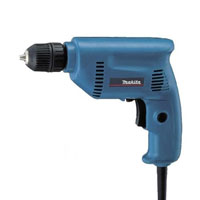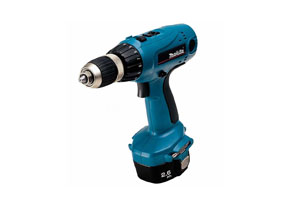 In this article, we want to describe the main points that you need to pay attention to when choosing a tool such as an electric drill. This tool, in our opinion, should be present in the set of any home master, and I think it is important that it be of high quality and functional.
In this article, we want to describe the main points that you need to pay attention to when choosing a tool such as an electric drill. This tool, in our opinion, should be present in the set of any home master, and I think it is important that it be of high quality and functional.
First, let's talk about what an electric drill is. This is an electric tool that is designed to create small diameter holes in a wide range of materials. Modern drills can drill metal, plastic, wood, as well as stone, concrete, brick, slate, etc. The main power element of this tool is a small electric motor, the rotation of which is transmitted by a drive mechanism to a drill made of high strength steel, which and creates a hole.
According to their design features, drills are battery-powered and conventional (powered via cable).
cordless drill
Let's say right away that in this article we are talking about electric drills, and not screwdrivers, which are similar in design to a drill, but have a significant difference in the mechanism for transmitting rotation to the work item. The truth will immediately say that there are practically no such left. It's easier to immediately include all the functions in the tool at once.
Cordless drills are used when a portable and lightweight tool is required to create holes away from power outlets. . Usually this is a finishing tool. As noted above, the main advantages of this tool are low weight and mobility. When you work, for example, on the roof of the house, and far from the power outlet, this is very convenient.
As disadvantages, it is worth noting the relatively short operating time of the tool, since drilling requires a lot of energy, and the battery charge is quite small. At the same time, the list of works that can be performed using a modern cordless drill is quite large. In our opinion, this is a fairly useful tool in the home toolbox, although professionals use it more.

conventional electric drill
This tool is more functional than a battery tool, has more power and, most importantly, an unlimited supply of energy, since this tool is powered by a 220 V household electrical outlet. Depending on the model, an electric drill can be equipped with various “bells and whistles”, but first things first.
Hammer drilling function
The simplest models of an electric drill can usually only drill materials such as metal, wood, plastic, ceramic tiles. As a rule, they are quite cheap and are equipped with an engine of various power. Usually, the more powerful the engine, the larger it is in size and larger diameter drills can be used in it. Gradually, these models are leaving the market, as most people need a tool that is also suitable for drilling wall materials: concrete, brick, plaster, etc.. For this, it is necessary that the electric drill has a perforation function.
Of course, for these purposes it is better to use a puncher, but most citizens do not puzzle themselves with a significant amount of work where this tool is needed. As a rule, in the house there is only a need to drill holes in the wall in order to hang a picture, a cabinet or a shelf. A small drill with an impact function for a drill with a maximum diameter of 13 mm is quite suitable for these purposes. For those who don't understand, the hammer or "impact" drilling function is a special mode.
During this mode, the drill not only rotates but also makes translational movements along the axis of the drill. As a result, the drill not only drills, but also hits like a hammer at the drilling point. Due to this mechanism, drilling of materials such as concrete or brick is much faster. By the way, drills with a winning tip are used to drill these materials.
Cartridge design
Well, we figured out the function of impact drilling and now let's move on to the design of the drill chuck. Depending on the model, the electric drill can be equipped with one of two types of cartridges (that part of the drill into which the drill is clamped). The first type of cartridge is a classic one with triangular clamping sectors and a forced clamping mechanism. The drill in the chuck is fixed by rotating part of the chuck with a special key, which has a gear element. In everyday life, when the amount of work is not very large and it is often necessary to change the type or size of the drill, this is not very convenient.
It is also worth noting that gradually the gear key and the teeth on the chuck are gradually developed and difficulties arise when fixing the drill. For household purposes, we would recommend an electric drill with a so-called keyless chuck. These types of cartridges clamp the drill when they are rotated simply by hand relative to the axis of the drill. They are more convenient when changing the drill frequently, since it takes just a few seconds to unscrew and tighten. Nevertheless, for these cartridges, the clamping strength of the drill is somewhat less, but for domestic purposes this is not critical. If you are buying a powerful drill, then it is better to stop at a model with a key chuck.


Additional features of the drill
When choosing a drill, you should also consider additional features that are very useful when drilling. Firstly, this is the presence of a constant drilling button. It allows you to “jam” the switching mechanism with one click and for constant drilling there is no need to constantly press the start button. True, based on practice, usually this function is not very used for small amounts of work.
When the drilling time is short enough, using the continuous drilling button is absolutely not practical. Another thing is the reverse function. With this function, you can switch the direction of rotation of the drill to the opposite. If you often work with metal with a thickness of more than 2 mm, then you cannot do without this function. The fact is that when you have almost drilled through the metal, there is a sharp breakthrough of the remaining thickness of the metal and the drill often gets stuck in the burrs. In order to pull out the drill, it is necessary to start rotating the drill in the opposite direction from the direction of rotation of the drill. The reverse function allows you to do this in a couple of seconds and without changing the position of the tool and hands.
Drill motor characteristics
The motor characteristics of the electric drill also deserve attention. The fact is that the stronger the material to be drilled, the more powerful the engine is needed. And if the size is large, then a weak motor may not be able to cope with the work. The smallest drills have a power of 250 watts, and powerful professional ones reach up to 1500 watts and more. Also, the power of the drill affects the very speed of drilling. For domestic purposes, an electric drill of 500 - 800 watts is quite suitable.
Another characteristic of the electric motor of the drill is the maximum number of revolutions of the engine. As a rule, this indicator for drills is almost the same and is 2600 - 3000 rpm. But there is one but. Many models have a special regulator that allows you to change the speed of rotation. This is very convenient, since metal, for example, needs to be drilled at a low speed, and for wood, the higher the speed, the better. Some models also have a regulation function built into the start button. The harder you press on it, the faster the speed. This allows you to adjust the rotation speed directly in the drilling process.
Drill diameter
This indicator is not very important when choosing a drill if you choose a drill for homework. Most models for household work are made for a maximum drill diameter of 13 mm. This is quite enough for all types of work at home. However, if you plan to use the tool for permanent work in construction, especially in the work of drilling logs and timber with thick drills, it is most likely better to take a drill with a larger drill diameter.
Accessories
When choosing an electric drill, you can also pay attention to additional accessories, the presence of which is not mandatory and is not critical for operation. However, if they are, work can become much more convenient and comfortable.
1. Additional handle. This device allows you to hold the drill with two hands, which allows you to better fix the drill in the desired position. It also reduces the chance that the drill will break if the tool moves to the side.
2. Drilling depth limiter. A very useful device in cases of drilling blind holes, for example, under a dowel in a wall. The limiter allows you to drill several holes accurately in depth without additional depth measurement with other tools.
3. Case. This type of device allows you to protect the tool from dust and excess moisture, besides, it is very convenient to carry a drill in it if you are not working at home, but in another place.
We hope the above information has helped you decide on the type and type of tool that you should purchase, however, we recommend that you do not limit yourself to this information and read about the technical characteristics of individual models for a more detailed comparison and final choice.
|
Useful articles |